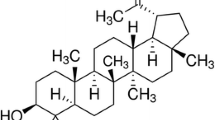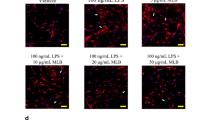Abstract
Neuroinflammation has been reported to be involved in the pathogenesis of Parkinson’s disease (PD). Inhibition of microglia-mediated neuroinflammation might be a potential strategy for PD treatment. Biochanin A, is an O-methylated isoflavone, classified as a kind of phytoestrogens due to its chemical structure that is similar to mammalian estrogens. It has been found to possess antifibrotic, antiapoptotic, and antioxidant effects. In the present study, we investigated the neuroprotective effects of biochanin A on lipopolysaccharide (LPS)-induced dopaminergic neurons damage both in vivo and in vitro and the related molecular mechanisms. The results showed that biochanin A treatment for 21 days significantly attenuated the behavioral dysfunction of PD rats, prevented dopaminergic neurons damage, and inhibited activation of microglia in the LPS-induced PD rats. Furthermore, biochanin A decreased the levels of interleukin-1β (IL-1β), interleukin-6 (IL-6), and tumor necrosis factor-α (TNF-α) in the serum, and inhibited the phosphorylation of ERK, JNK, p38 in the substantia nigra of PD rats. In vitro test, biochanin A also inhibited primary microglial activation and protected dopaminergic neurons, decreased the content of nitric oxide, IL-1β, and TNF-α in supernatants, and inhibited the reactive oxygen species production. Taken together, these results suggest that biochanin A exerts protective effects on LPS-induced PD rats, and the mechanisms may be associated with the inhibition of inflammatory response and the MAPK signaling pathway.











Similar content being viewed by others
References
Breikaa RM, Algandaby MM, El-Demerdash E, Abdel-Naim AB (2013) Multimechanistic antifibrotic effect of biochanin A in rats: implications of proinflammatory and profibrogenic mediators. PLoS One 8(7):e69276
Carta AR, Frau L, Pisanu A, Wardas J, Spiga S, Carboni E (2011) Rosiglitazone decreases peroxisome proliferator receptor-gamma levels in microglia and inhibits TNF-alpha production: new evidences on neuroprotection in a progressive Parkinson’s disease model. Neuroscience 194:250–261
Chen HQ, Jin ZY, Li GH (2007) Biochanin A protects dopaminergic neurons against lipopolysaccharide- induced damage through inhibition of microglia activation and proinflammatory factors generation. Neurosci Lett 417(2):112–117
Collins LM, Toulouse A, Connor TJ, Nolan YM (2012) Contributions of central and systemic inflammation to the pathophysiology of Parkinson’s disease. Neuropharmacology 62(7):2154–2168
Dou W, Zhang J, Ren G, Ding L, Sun A, Deng C, Wu X, Wei X, Mani S, Wang Z (2014) Mangiferin attenuates the symptoms of dextran sulfate sodium-induced colitis in mice via NF-κB and MAPK signaling inactivation. Int Immunopharmacol 23(1):170–178
Frank-Cannon TC, Alto LT, McAlpine FE, Tansey MG (2009) Does neuroinflammation fan the flame in neurodegenerative diseases? Mol Neurodegener 16(4):47
Gao HM, Hong JS (2008) Why neurodegenerative diseases are progressive: uncontrolled inflammation drives disease progression. Trends Immunol 29(8):357–365
Gao HM, Liu B, Zhang W, Hong JS (2003) Critical role of microglial NADPH oxidase derived free radicals in the in vitro MPTP model of Parkinson’s disease. FASEB J 17:1954–1956
Hefti F, Melamed E, Sahakian BJ, Wurtman RJ (1980) Circling behavior in rats with partial, unilateral nigro-striatal lesions: effect of amphetamine, apomorphine, and DOPA. Pharmacol Biochem Behav 12(2):185–188
Hoban DB, Connaughton E, Connaughton C, Hogan G, Thornton C, Mulcahy P, Moloney TC, Dowd E (2013) Further characterisation of the LPS model of Parkinson’s disease: a comparison of intra-nigral and intra-striatal lipopolysaccharide administration on motor function, microgliosis and nigrostriatal neurodegeneration in the rat. Brain Behav Immun 27(1):91–100
Iancu R, Mohapel P, Brundin P, Paul G (2005) Behavioral characterization of a unilateral 6-OHDA-lesion model of Parkinson’s disease in mice. Behav Brain Res 162(1):1–10
Jankovic J (2008) Parkinson’s disease: clinical features and diagnosis. J Neurol Neurosurg Psychiatry 79(4):368–376
Jeohn GH, Kong LY, Wilson B, Hudson P, Hong JS (1998) Synergistic neurotoxic effects of combined treatments with cytokines in murine primary mixed neuron/glia cultures. J Neuroimmunol 85(1):1–10
Kim WG, Mohney RP, Wilson B, Jeohn GH, Liu B, Hong JS (2000) Regional difference in the susceptibility to lipopolysaccharide-induced neurotoxicity in the rat brain: role of microglia. J Neurosci 20(16):6309–6316
Kreutzberg GW (1996) Microglia: a sensor for pathological events in the CNS. Trends Neurosci 19(8):312–318
Le W, Rowe D, Xie W, Ortiz I, He Y, Appel SH (2001) Microglial activation and dopaminergic cell injury: an in vitro model relevant to Parkinson’s disease. J Neurosci 21(21):8447–8455
Li YY, Huang SS, Lee MM, Deng JS, Huang GJ (2015) Anti-inflammatory activities of cardamonin from Alpinia katsumadai through heme oxygenase-1 induction and inhibition of NF-κB and MAPK signaling pathway in the carrageenan-induced paw edema. Int Immunopharmacol 25(2):332–339
Liu B, Du L, Hong JS (2000a) Naloxone protects rat dopaminergic neurons against inflammatory damage through inhibition of microglia activation and superoxide generation. J Pharmacol Exp Ther 293(2):607–617
Liu M, Bing G (2011) Lipopolysaccharide animal models for Parkinson’s disease. Parkinsons Dis 2011:327089
Liu B, Jiang JW, Wilson BC, Du L, Yang SN, Wang JY, Wu GC, Cao XD, Hong JS (2000b) Systemic infusion of naloxone reduces degeneration of rat substantia nigral dopaminergic neurons induced by intranigral injection of lipopolysaccharide. J Pharmacol Exp Ther 295(1):125–132
Lu X, Bing G, Hagg T (2000) Naloxone prevents microglia-induced degeneration of dopaminergic substantia nigra neurons in adult rats. Neuroscience 97(2):285–291
McGeer PL, Itagaki S, Boyes BE, McGeer EG (1988) Reactive microglia are positive for HLA-DR in the substantia nigra of Parkinson’s and Alzheimer’s disease brains. Neurology 38(8):1285–1291
Qian L, Flood PM, Hong JS (2010) Neuroinflammation is a key player in Parkinson’s disease and a prime target for therapy. J Neural Transm. 117(8):971–979
Tai W, Ye X, Bao X, Zhao B, Wang X, Zhang D (2013) Inhibition of Src tyrosine kinase activity by squamosamide derivative FLZ attenuates neuroinflammation in both in vivo and in vitro Parkinson’s disease models. Neuropharmacology 75:201–212
Tan JW, Tham CL, Israf DA, Lee SH, Kim MK (2013) Neuroprotective effects of biochanin A against glutamate-induced cytotoxicity in PC12 cells via apoptosis inhibition. Neurochem Res 38(3):512–518
Tansey MG, Goldberg MS (2010) Neuroinflammation in Parkinson’s disease: its role in neuronal death and implications for therapeutic intervention. Neurobiol Dis 37(3):510–518
Wang X, Chen S, Ma G, Ye M, Lu G (2005) Genistein protects dopaminergic neurons by inhibiting microglial activation. NeuroReport 16(3):267–270
Wang W, Tang L, Li Y, Wang Y (2015) Biochanin A protects against focal cerebral ischemia/reperfusion in rats via inhibition of p38-mediated inflammatory responses. J Neurol Sci 348(1–2):121–125
Wu WY, Wu YY, Huang H, He C, Li WZ, Wang HL, Chen HQ, Yin YY (2015) Biochanin A attenuates LPS-induced pro-inflammatory responses and inhibits the activation of the MAPK pathway in BV2 microglial cells. Int J Mol Med 35(2):391–398
Zhang Y, Guo J, Zeng L, Zhang J, Hui Y, Liu J, Qing X, Sun X, Guo G (2011) Tert-butyl-2(4,5-dihydrogen-4,4,5,5-tetramethyl-3-O-1H-imidazole-3-cationic-1-oxyl-2-pyrrolidine-1-carboxylic ester displays novel cytotoxicity through reactive oxygen species-mediated oxidative damage in MCF-7 and MDA-MB-231 cells. Chem Biol Interact 192(3):287–297
Zhou HF, Liu XY, Niu DB, Li FQ, He QH, Wang XM (2005) Triptolide protects dopaminergic neurons from inflammation-mediated damage induced by lipopolysaccharide intranigral injection. Neurobiol Dis 18(3):441–449
Acknowledgments
This work was supported by the National Natural Science Foundation of China (NSFC) fund (Grant No. 31171650) and the Natural Science Foundation of Anhui Province Education Department (Grant No. KJ2014A115) and the Natural Science Foundation of Anhui Province (Grant No. 1508085MH186).
Author information
Authors and Affiliations
Corresponding authors
Ethics declarations
Conflict of interest
The authors declare no conflict of interest.
Additional information
J. Wang and W.-Y. Wu these authors contributed equally to this work.
Electronic supplementary material
Below is the link to the electronic supplementary material.
Rights and permissions
About this article
Cite this article
Wang, J., Wu, WY., Huang, H. et al. Biochanin A Protects Against Lipopolysaccharide-Induced Damage of Dopaminergic Neurons Both In Vivo and In Vitro via Inhibition of Microglial Activation. Neurotox Res 30, 486–498 (2016). https://doi.org/10.1007/s12640-016-9648-y
Received:
Revised:
Accepted:
Published:
Issue Date:
DOI: https://doi.org/10.1007/s12640-016-9648-y




